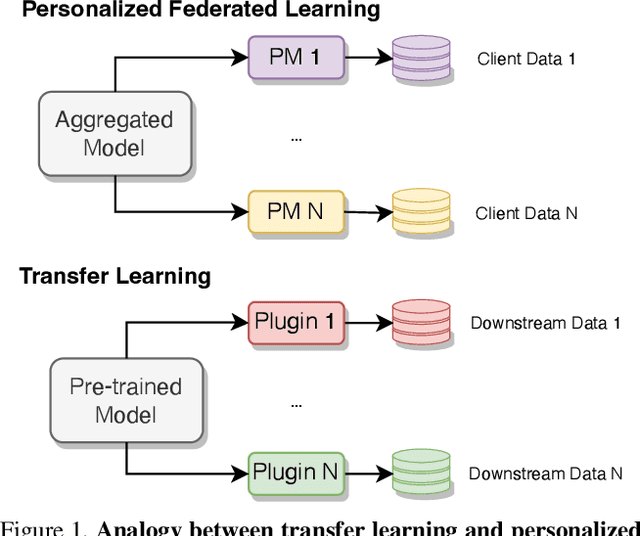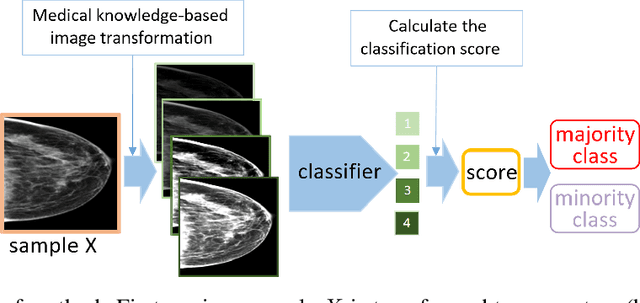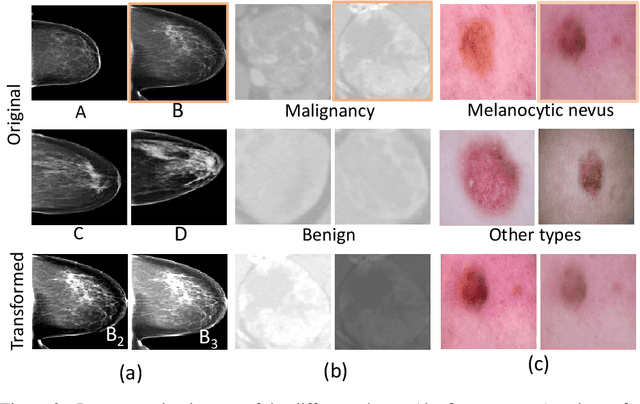Shandong Wu
Longitudinal Mammogram Exam-based Breast Cancer Diagnosis Models: Vulnerability to Adversarial Attacks
Oct 29, 2024



Abstract:In breast cancer detection and diagnosis, the longitudinal analysis of mammogram images is crucial. Contemporary models excel in detecting temporal imaging feature changes, thus enhancing the learning process over sequential imaging exams. Yet, the resilience of these longitudinal models against adversarial attacks remains underexplored. In this study, we proposed a novel attack method that capitalizes on the feature-level relationship between two sequential mammogram exams of a longitudinal model, guided by both cross-entropy loss and distance metric learning, to achieve significant attack efficacy, as implemented using attack transferring in a black-box attacking manner. We performed experiments on a cohort of 590 breast cancer patients (each has two sequential mammogram exams) in a case-control setting. Results showed that our proposed method surpassed several state-of-the-art adversarial attacks in fooling the diagnosis models to give opposite outputs. Our method remained effective even if the model was trained with the common defending method of adversarial training.
Mixture of Experts Made Personalized: Federated Prompt Learning for Vision-Language Models
Oct 14, 2024Abstract:Prompt learning for pre-trained Vision-Language Models (VLMs) like CLIP has demonstrated potent applicability across diverse downstream tasks. This lightweight approach has quickly gained traction from federated learning (FL) researchers who seek to efficiently adapt VLMs to heterogeneous scenarios. However, current federated prompt learning methods are habitually restricted to the traditional FL paradigm, where the participating clients are generally only allowed to download a single globally aggregated model from the server. While justifiable for training full-sized models under federated settings, in this work, we argue that this paradigm is ill-suited for lightweight prompts. By facilitating the clients to download multiple pre-aggregated prompts as fixed non-local experts, we propose Personalized Federated Mixture of Adaptive Prompts (pFedMoAP), a novel FL framework that personalizes the prompt learning process through the lens of Mixture of Experts (MoE). pFedMoAP implements a local attention-based gating network that learns to generate enhanced text features for better alignment with local image data on the client, benefiting from both local and downloaded non-local adaptive prompt experts. The non-local experts are sparsely selected from a server-maintained pool, fostering collaborative learning across clients. To evaluate the proposed algorithm, we conduct extensive experiments across 9 datasets under various heterogeneous federated settings. The results show that pFedMoAP consistently outperforms the state-of-the-art alternatives, underscoring its efficacy in personalizing prompt learning for CLIP within the federated learning paradigm.
Adversarially Robust Feature Learning for Breast Cancer Diagnosis
Feb 13, 2024Abstract:Adversarial data can lead to malfunction of deep learning applications. It is essential to develop deep learning models that are robust to adversarial data while accurate on standard, clean data. In this study, we proposed a novel adversarially robust feature learning (ARFL) method for a real-world application of breast cancer diagnosis. ARFL facilitates adversarial training using both standard data and adversarial data, where a feature correlation measure is incorporated as an objective function to encourage learning of robust features and restrain spurious features. To show the effects of ARFL in breast cancer diagnosis, we built and evaluated diagnosis models using two independent clinically collected breast imaging datasets, comprising a total of 9,548 mammogram images. We performed extensive experiments showing that our method outperformed several state-of-the-art methods and that our method can enhance safer breast cancer diagnosis against adversarial attacks in clinical settings.
FedPerfix: Towards Partial Model Personalization of Vision Transformers in Federated Learning
Aug 17, 2023



Abstract:Personalized Federated Learning (PFL) represents a promising solution for decentralized learning in heterogeneous data environments. Partial model personalization has been proposed to improve the efficiency of PFL by selectively updating local model parameters instead of aggregating all of them. However, previous work on partial model personalization has mainly focused on Convolutional Neural Networks (CNNs), leaving a gap in understanding how it can be applied to other popular models such as Vision Transformers (ViTs). In this work, we investigate where and how to partially personalize a ViT model. Specifically, we empirically evaluate the sensitivity to data distribution of each type of layer. Based on the insights that the self-attention layer and the classification head are the most sensitive parts of a ViT, we propose a novel approach called FedPerfix, which leverages plugins to transfer information from the aggregated model to the local client as a personalization. Finally, we evaluate the proposed approach on CIFAR-100, OrganAMNIST, and Office-Home datasets and demonstrate its effectiveness in improving the model's performance compared to several advanced PFL methods.
Human not in the loop: objective sample difficulty measures for Curriculum Learning
Feb 02, 2023



Abstract:Curriculum learning is a learning method that trains models in a meaningful order from easier to harder samples. A key here is to devise automatic and objective difficulty measures of samples. In the medical domain, previous work applied domain knowledge from human experts to qualitatively assess classification difficulty of medical images to guide curriculum learning, which requires extra annotation efforts, relies on subjective human experience, and may introduce bias. In this work, we propose a new automated curriculum learning technique using the variance of gradients (VoG) to compute an objective difficulty measure of samples and evaluated its effects on elbow fracture classification from X-ray images. Specifically, we used VoG as a metric to rank each sample in terms of the classification difficulty, where high VoG scores indicate more difficult cases for classification, to guide the curriculum training process We compared the proposed technique to a baseline (without curriculum learning), a previous method that used human annotations on classification difficulty, and anti-curriculum learning. Our experiment results showed comparable and higher performance for the binary and multi-class bone fracture classification tasks.
PGFed: Personalize Each Client's Global Objective for Federated Learning
Dec 02, 2022Abstract:The mediocre performance of conventional federated learning (FL) over heterogeneous data has been facilitating personalized FL solutions, where, unlike conventional FL which trains a single global consensus model, different models are allowed for different clients. However, in most existing personalized FL algorithms, the collaborative knowledge across the federation was only implicitly passed to the clients in ways such as model aggregation or regularization. We observed that this implicit knowledge transfer fails to maximize the potential value of each client's empirical risk toward other clients. Based on our observation, in this work, we propose Personalized Global Federated Learning (PGFed), a novel personalized FL framework that enables each client to personalize its own global objective by explicitly and adaptively aggregating the empirical risks of itself and other clients. To avoid massive ($O(N^2)$) communication overhead and potential privacy leakage, each client's risk is estimated through a first-order approximation for other clients' adaptive risk aggregation. On top of PGFed, we develop a momentum upgrade, dubbed PGFedMo, to more efficiently utilize clients' empirical risks. Our extensive experiments under different federated settings with benchmark datasets show consistent improvements of PGFed over the compared state-of-the-art alternatives.
Cross-Domain Self-Supervised Deep Learning for Robust Alzheimer's Disease Progression Modeling
Nov 15, 2022Abstract:Developing successful artificial intelligence systems in practice depends both on robust deep learning models as well as large high quality data. Acquiring and labeling data can become prohibitively expensive and time-consuming in many real-world applications such as clinical disease models. Self-supervised learning has demonstrated great potential in increasing model accuracy and robustness in small data regimes. In addition, many clinical imaging and disease modeling applications rely heavily on regression of continuous quantities. However, the applicability of self-supervised learning for these medical-imaging regression tasks has not been extensively studied. In this study, we develop a cross-domain self-supervised learning approach for disease prognostic modeling as a regression problem using 3D images as input. We demonstrate that self-supervised pre-training can improve the prediction of Alzheimer's Disease progression from brain MRI. We also show that pre-training on extended (but not labeled) brain MRI data outperforms pre-training on natural images. We further observe that the highest performance is achieved when both natural images and extended brain-MRI data are used for pre-training.
Medical Knowledge-Guided Deep Learning for Imbalanced Medical Image Classification
Nov 20, 2021



Abstract:Deep learning models have gained remarkable performance on a variety of image classification tasks. However, many models suffer from limited performance in clinical or medical settings when data are imbalanced. To address this challenge, we propose a medical-knowledge-guided one-class classification approach that leverages domain-specific knowledge of classification tasks to boost the model's performance. The rationale behind our approach is that some existing prior medical knowledge can be incorporated into data-driven deep learning to facilitate model learning. We design a deep learning-based one-class classification pipeline for imbalanced image classification, and demonstrate in three use cases how we take advantage of medical knowledge of each specific classification task by generating additional middle classes to achieve higher classification performances. We evaluate our approach on three different clinical image classification tasks (a total of 8459 images) and show superior model performance when compared to six state-of-the-art methods. All codes of this work will be publicly available upon acceptance of the paper.
Constrained Deep One-Class Feature Learning For Classifying Imbalanced Medical Images
Nov 20, 2021



Abstract:Medical image data are usually imbalanced across different classes. One-class classification has attracted increasing attention to address the data imbalance problem by distinguishing the samples of the minority class from the majority class. Previous methods generally aim to either learn a new feature space to map training samples together or to fit training samples by autoencoder-like models. These methods mainly focus on capturing either compact or descriptive features, where the information of the samples of a given one class is not sufficiently utilized. In this paper, we propose a novel deep learning-based method to learn compact features by adding constraints on the bottleneck features, and to preserve descriptive features by training an autoencoder at the same time. Through jointly optimizing the constraining loss and the autoencoder's reconstruction loss, our method can learn more relevant features associated with the given class, making the majority and minority samples more distinguishable. Experimental results on three clinical datasets (including the MRI breast images, FFDM breast images and chest X-ray images) obtains state-of-art performance compared to previous methods.
Deep Curriculum Learning in Task Space for Multi-Class Based Mammography Diagnosis
Oct 21, 2021



Abstract:Mammography is used as a standard screening procedure for the potential patients of breast cancer. Over the past decade, it has been shown that deep learning techniques have succeeded in reaching near-human performance in a number of tasks, and its application in mammography is one of the topics that medical researchers most concentrate on. In this work, we propose an end-to-end Curriculum Learning (CL) strategy in task space for classifying the three categories of Full-Field Digital Mammography (FFDM), namely Malignant, Negative, and False recall. Specifically, our method treats this three-class classification as a "harder" task in terms of CL, and create an "easier" sub-task of classifying False recall against the combined group of Negative and Malignant. We introduce a loss scheduler to dynamically weight the contribution of the losses from the two tasks throughout the entire training process. We conduct experiments on an FFDM datasets of 1,709 images using 5-fold cross validation. The results show that our curriculum learning strategy can boost the performance for classifying the three categories of FFDM compared to the baseline strategies for model training.
 Add to Chrome
Add to Chrome Add to Firefox
Add to Firefox Add to Edge
Add to Edge